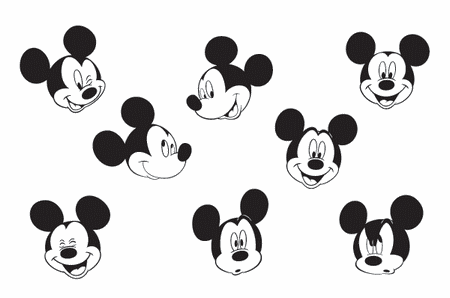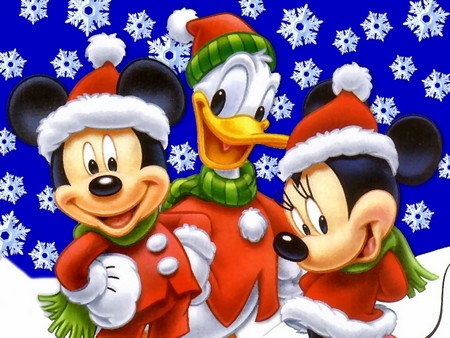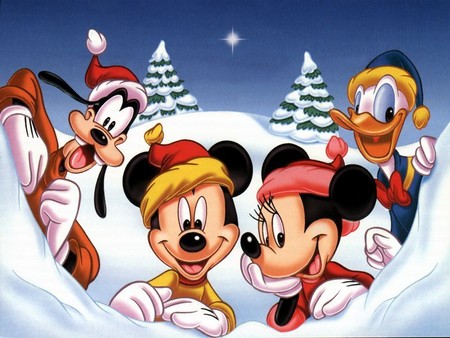History of Mickey Mouse
Mickey Mouse is a cartoon character of a talking mouse owned by The Walt Disney Company, and a very strong franchise for the company as well as its main character for promoting the company’s television channel, the various Disney theme parks, and merchandising opportunities. Mickey Mouse is distinctive and quite unique amongst cartoon characters with large black ears and a pointy nose, red shorts with white buttons, and large yellow construction boots. The silhouette of Mickey’s ears and nose are the logo of The Walt Disney Company.
The origins of the Mickey Mouse character are clouded in history, with different stories appearing to suit the whims of publishers, copyright holders, and those looking for a mystery, and with all of the original parties to his creation having passed away we may never know the real truth. The Walt Disney Company claims that the characters was of course created by Walt Disney (1901-1966) himself, the founder of the company, and that Walt based his original drawings on the humanized antics of a mouse Walt adopted while living in Kansas City and working for the Kansas City Film Ad Company in the early 1920s.

Disney recollected in later interviews that he drew a series of sketches of a cartoon mouse, and that long time friend and colleague Ub Iwerks reworked the sketches into a form that would make the characters easier and faster to draw, by all accounts simplifying the character into a series of straight lines and curves. Walt provided the voice, and the attitude and personality of Mickey Mouse, leading many of Disney’s animation colleagues of the time to describe Walt as the real life father of Mickey Mouse, as well as the rightful designer of the character.
An opposing story tells that a mouse character had originally been drawn by Hugh Harman around a photograph of Walt Disney in 1925, and that these were subsequently used as the idea for a new character when Disney went his separate ways from Universal Studios where he was contracted to provide shorts based on a character named “Oswald the Lucky Rabbit”. Disney needed to create a new character since he had signed over the rights for Oswald to Universal, so asked Ub Iwerks to come up with some ideas, some of which included cats, dogs, frogs, horses, and cows.
It wasn’t until after Iwerks was nearly at his wits end that he remembered seeing Harman’s mouse sketches around the photo of Walt that both he and Walt Disney finally agreed they were on to a winner with a mouse character with big ears and wearing a pair of shorts. They envisaged the mouse being human like, a bit of a struggler against whom fate always set an obstacle or challenge and which he would overcome through effort a good nature, and patience. They named their character Mortimer Mouse.

Mortimer struggled to find an identity, with Walt’s wife Lillian convinced the name was a bit to snobbish and would detract from the character’s audience appeal. Disney wanted his new studio’s primary character to be lovable, cute and little, traits he believed made it easy for children to fall in love with. In a later interview, Walt credited part of the personality of Mickey Mouse to Charlie Chaplin, a cute lovable character who thru no fault of his own always seemed to be getting into trouble. Mickey Rooney is on record as saying that Walt confided he chose the name Mickey after seeing Mickey McGuire, a character played by the young Mickey Rooney in the early 1920s.
By May 1928 the first Mickey Mouse short was ready for distribution, entitled Plane Crazy it featured Mickey and Minnie Mouse and a plane that Mickey had built. Mickey invites Minnie for the first flight and after take off attempts to kiss Minnie who jumps out of the plane with a parachute leaving Mickey to his adventure, which is of course filled with mishaps. The short failed to find a distributor so a second short, The Gallopin’ Gaucho was filmed and introduced Pegleg Pete, who had previously been seen in other Disney animations, as Mickey’s rival for Minnies affections. This too failed to find a distributor.
The Gallopin’ Gaucho was an unusual production in the Mickey was seen in two different designs, beginning the short looking like he did in Plane Crazy, notably with a black face and white eyes with black pupile, and in one of the cantina scenes Mickey is showing his teeth whilst smoking a cigarette or drinking a beer. Coincidentally at the time Mickey rescues Minnie from Pete and becomes her hero, his appearance changes to a white face with solid black eyes. Charges of racism have been leveled against this animation, but never sustained in a court of law.
The first Mickey Mouse animated short to find a distributor was Steamboat Willie, released November 1928, and again featuring Mickey, Minnie, and Pete who appears as the captain of the boat. Mickey himself appeared closely resembling the Mickey who became the hero in Gallopin’ Gaucho. Steamboat Willie proved an immediate hit with audiences loving the use of music and sound effects to add humor to the production, and encouraging Disney to fully adopt sound in all animations, including Mickey’s first spoken words in the 1929 production of The Karnival Kid.
A minor change to Mickey and Minnie’s appearance occurred in late 1929, they characters sported a smart pair of white gloves, which were added after complaints that viewers couldn’t see what they were doing with their hands when facing the camera. All Disney animation were still being filmed in black and white, so white gloves allowed the hands to contrast with other black parts of their bodies. By the early 1930s Mickey Mouse had overtaken Felix the Cat as Americas favorite cartoon animation, and Mortimer Mouse had been introduced as Minnie Mouse’s rancher uncle.

In 1935, a new animator at the Disney Company redesigned Mickey Mouse, returning the white eyes and black pupils, but also shortening Mickey’s nose, and giving his body a makeover, converting the round torso to an ellipse, as well as making Mickey’s face wider. In 1978, the 50th anniversary of Mickey Mouse’s first short film being produced and distributed, The Disney Company organized a huge extravaganza at Disneyland in California, with shows and some of the largest fireworks displays ever seen at the time. Mickey was also awarded a star on Hollywood Boulevard, the first cartoon character to ever receive a star.
As well, the Disney Company was operating Mickey Mouse Clubs in cinemas throughout the US and claiming over a million members, for whom specially discounted prices of Mickey Mouse merchandise were available, as well,the members would receive coloring books and badges. By the mid 1930s the administrative costs of managing these proved uneconomic, and they were closed down, but again in 1955 thru 1959 the Mickey Mouse Club was revived as a television series broadcast Monday to Friday.
The Mickey Mouse Club also aired in the 1970s, and then again in the 1990s, with many famous pop celebrities getting their first broadcasting role as cast members of the revived show, amngst them Christina Aguilera, Britney Spears, and Justin Timberlake. In 2006, a new format show named the Mickey Mouse Clubhouse began airing, however the show was aimed at preschoolers and isn’t a successor to the Mickey Mouse Club which The Disney Company reserve the right to revive.
